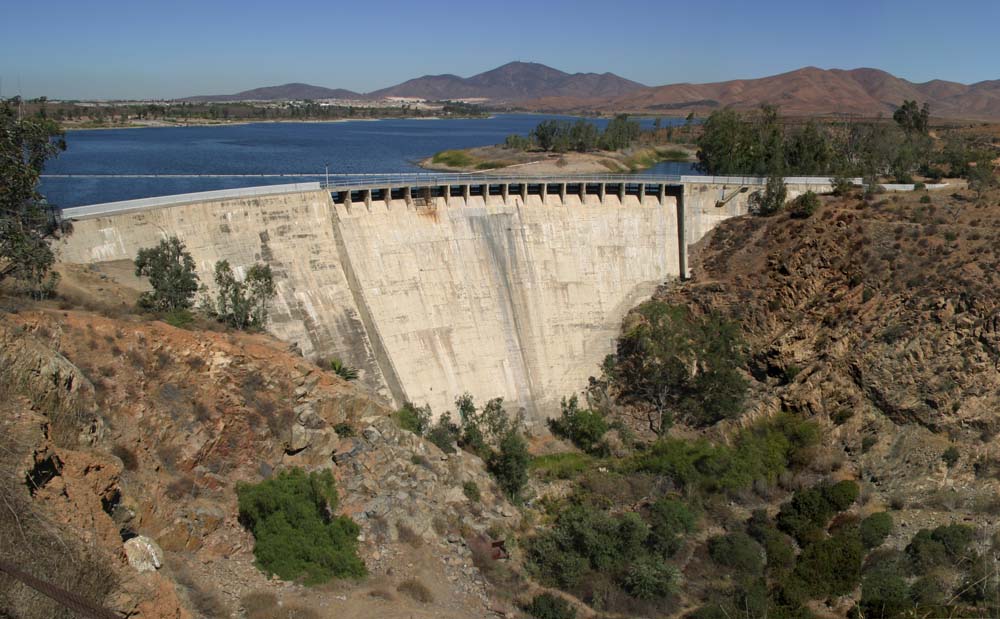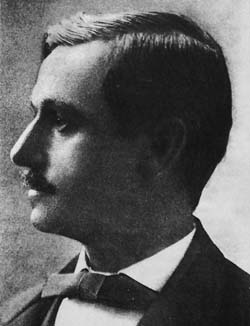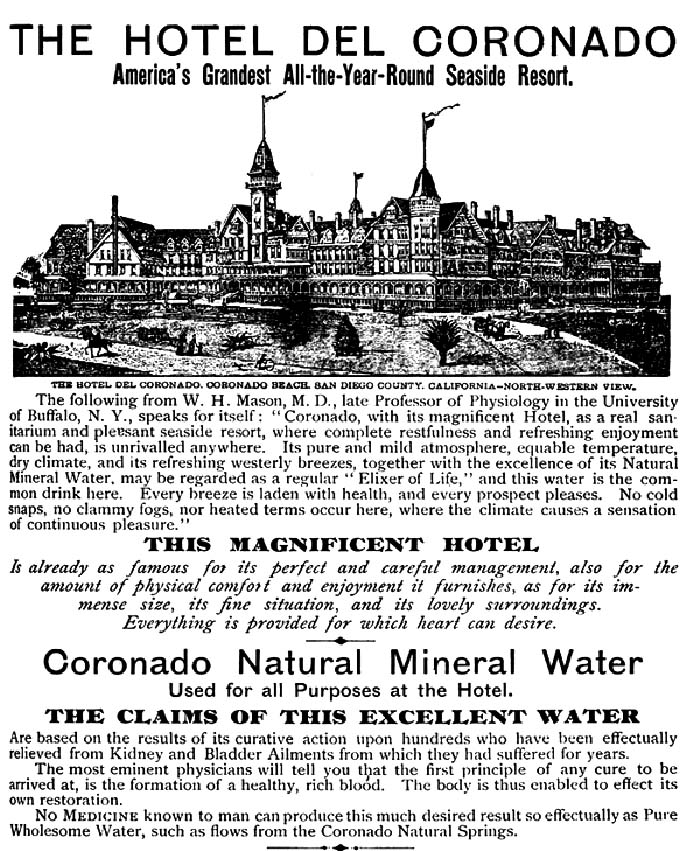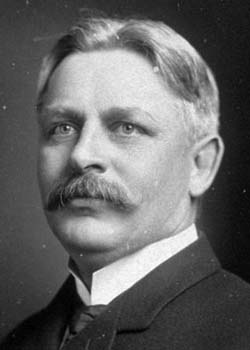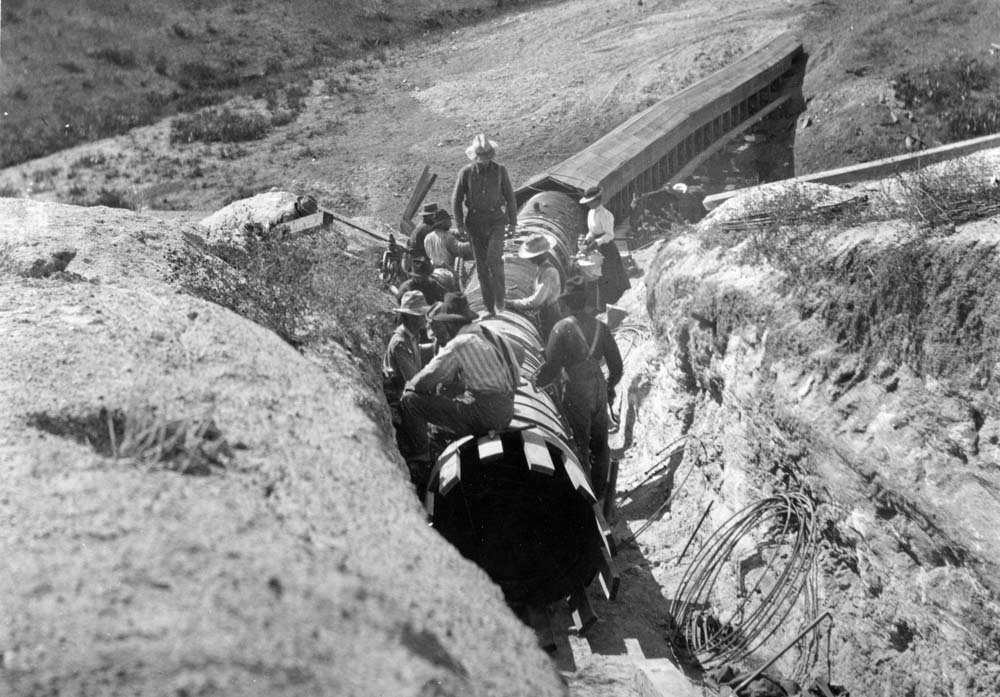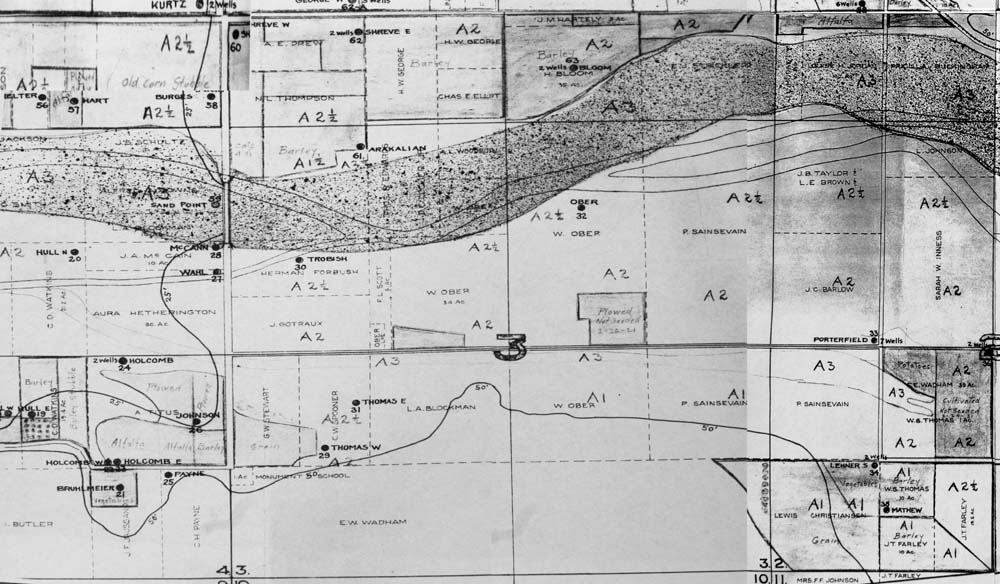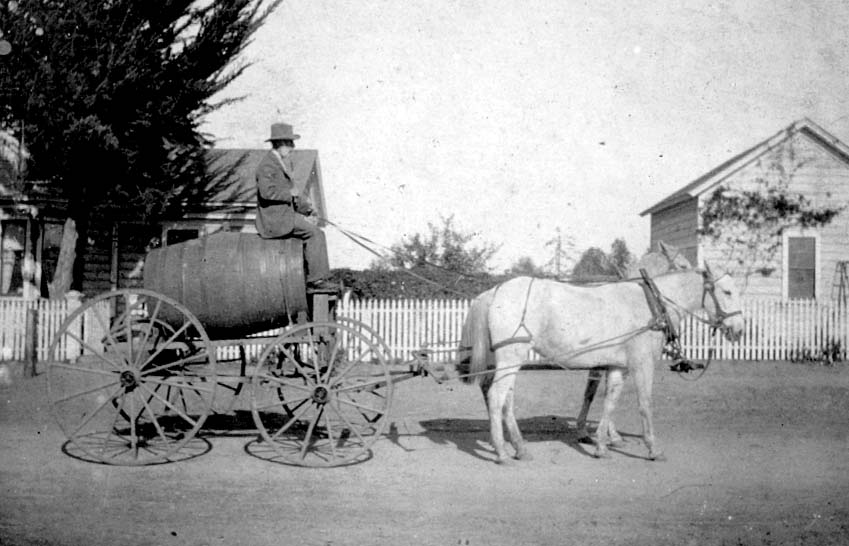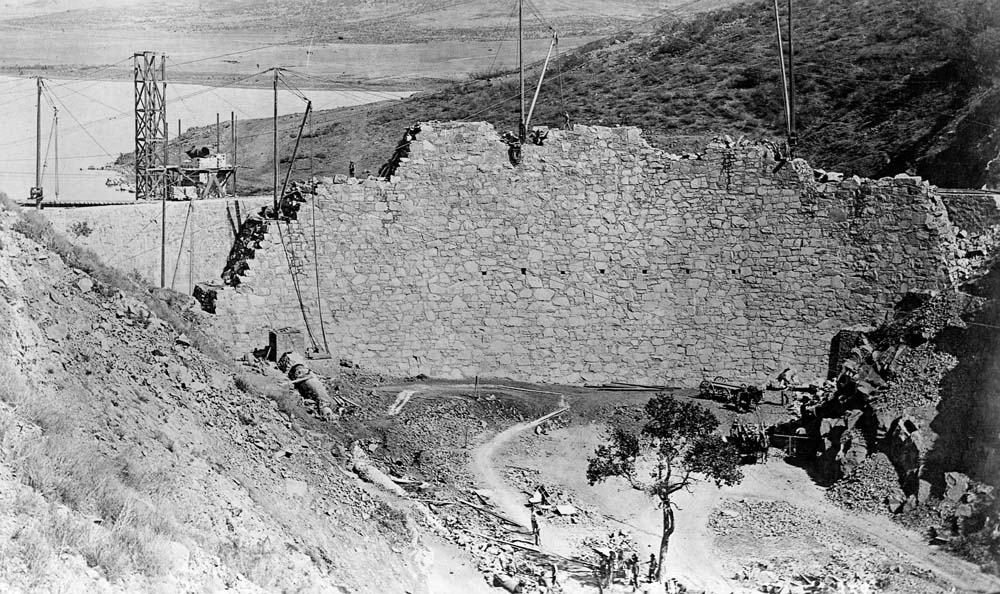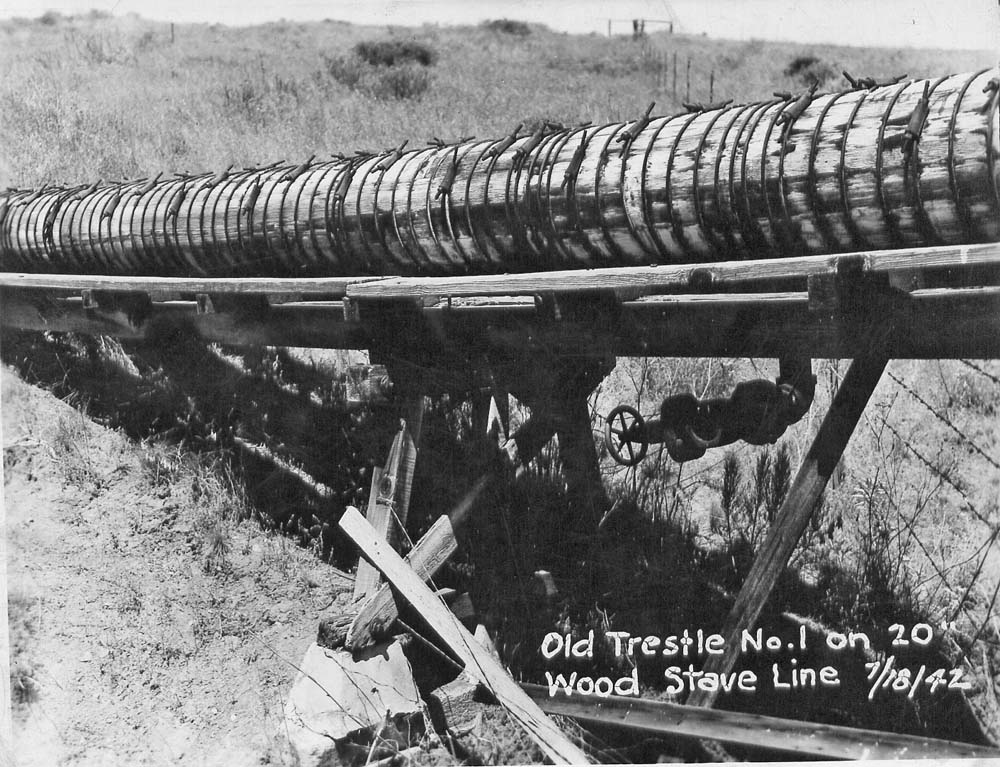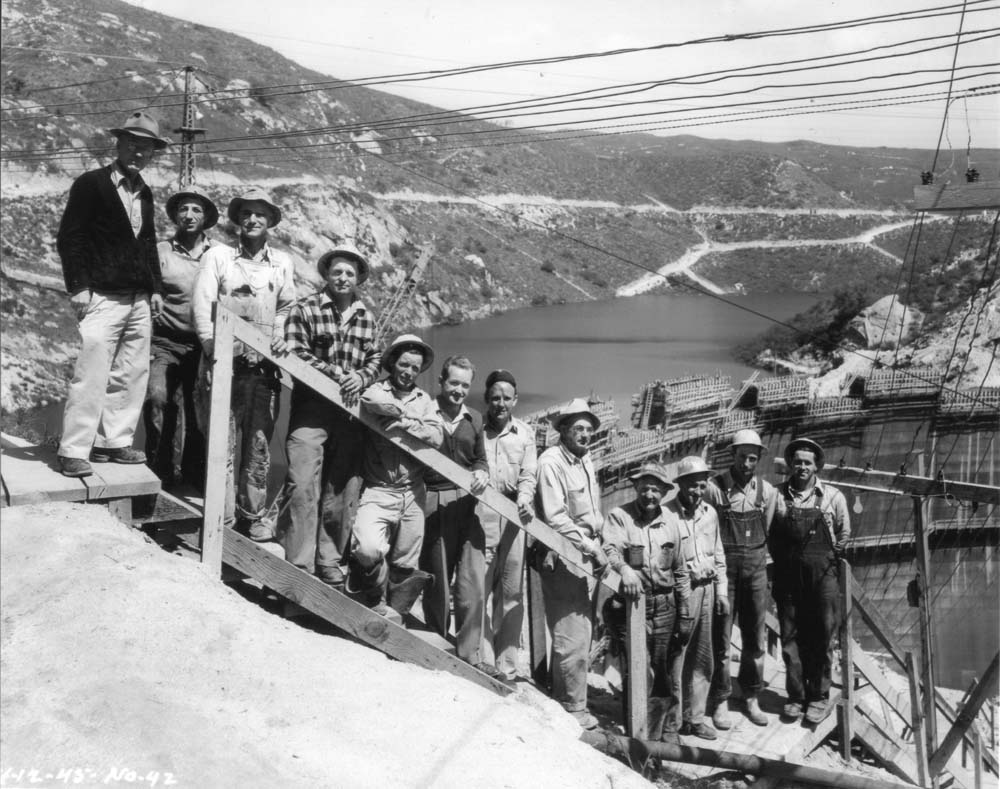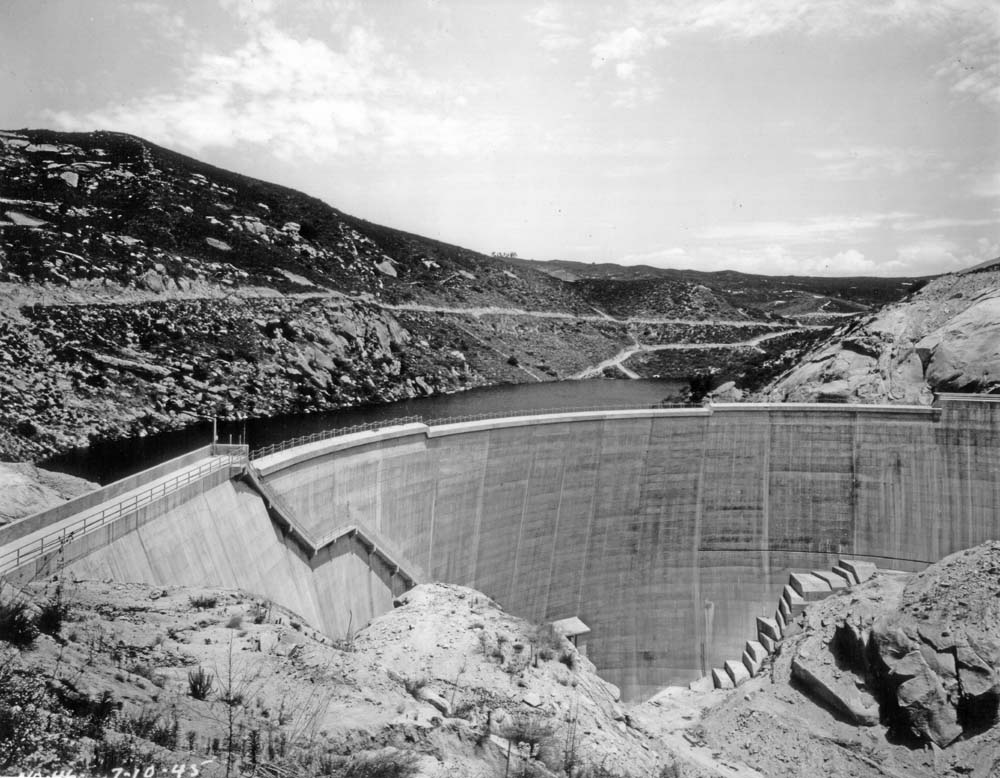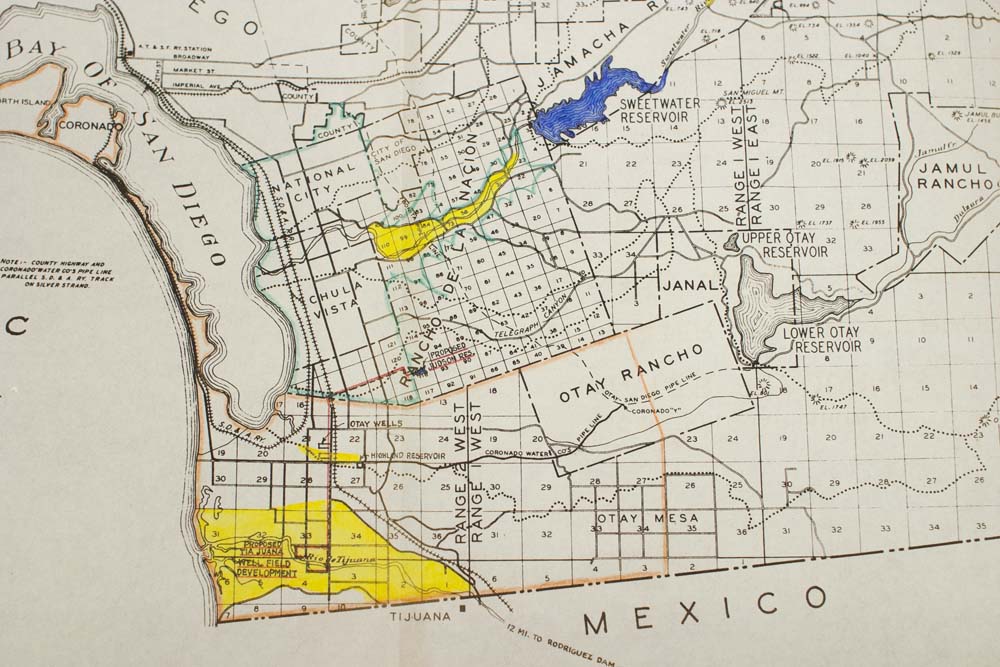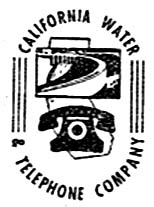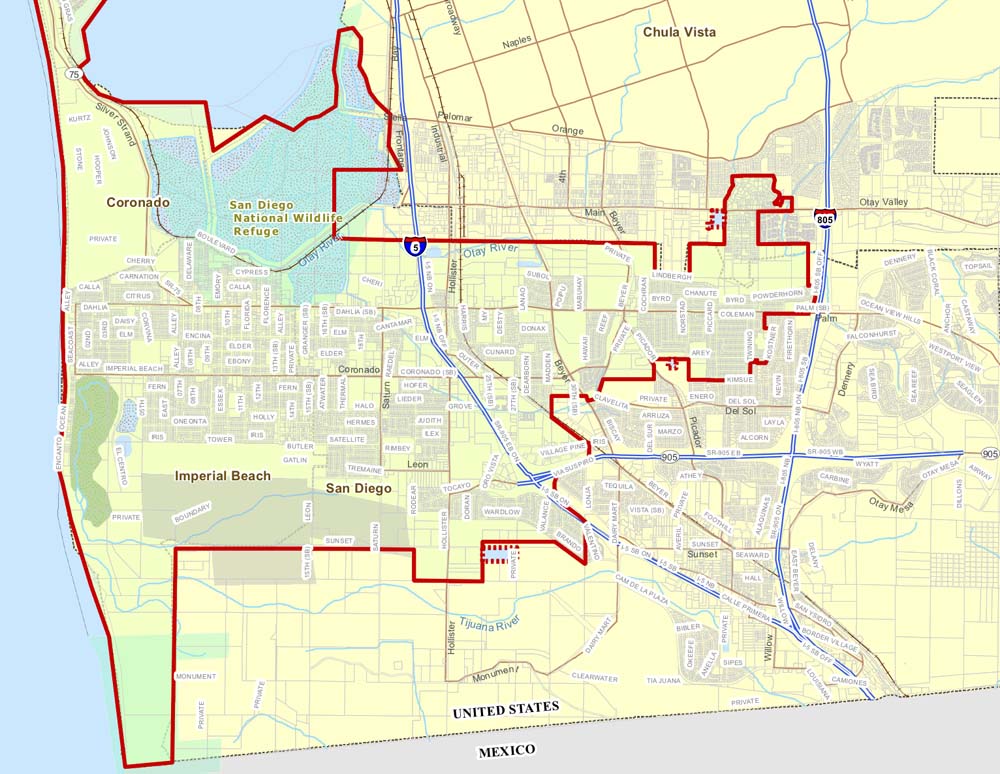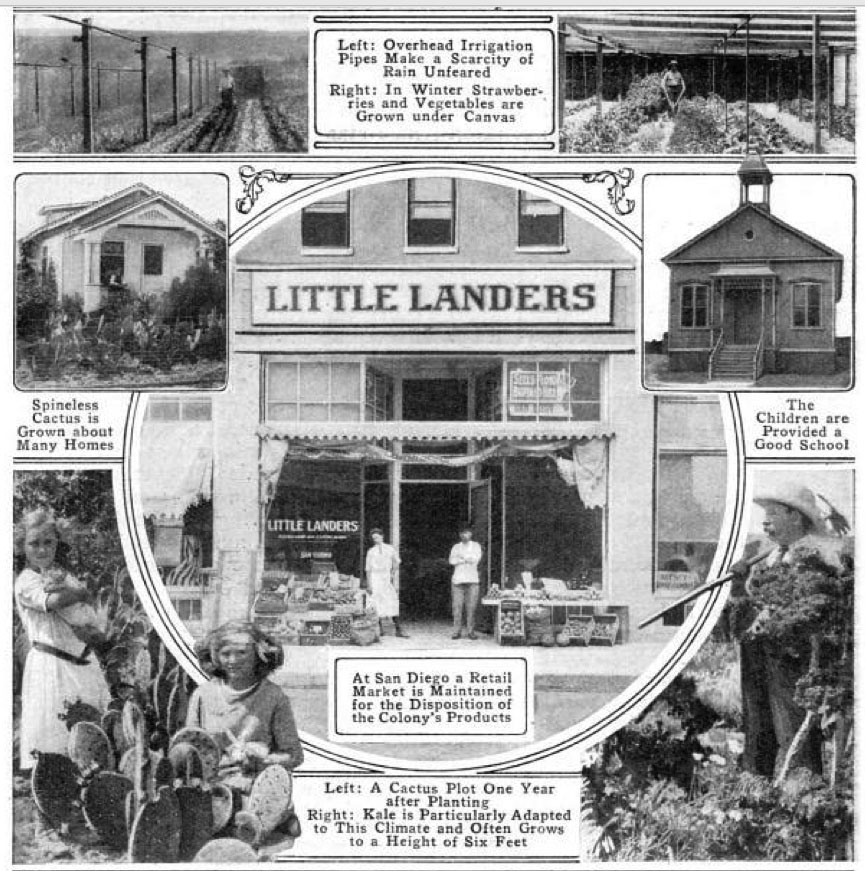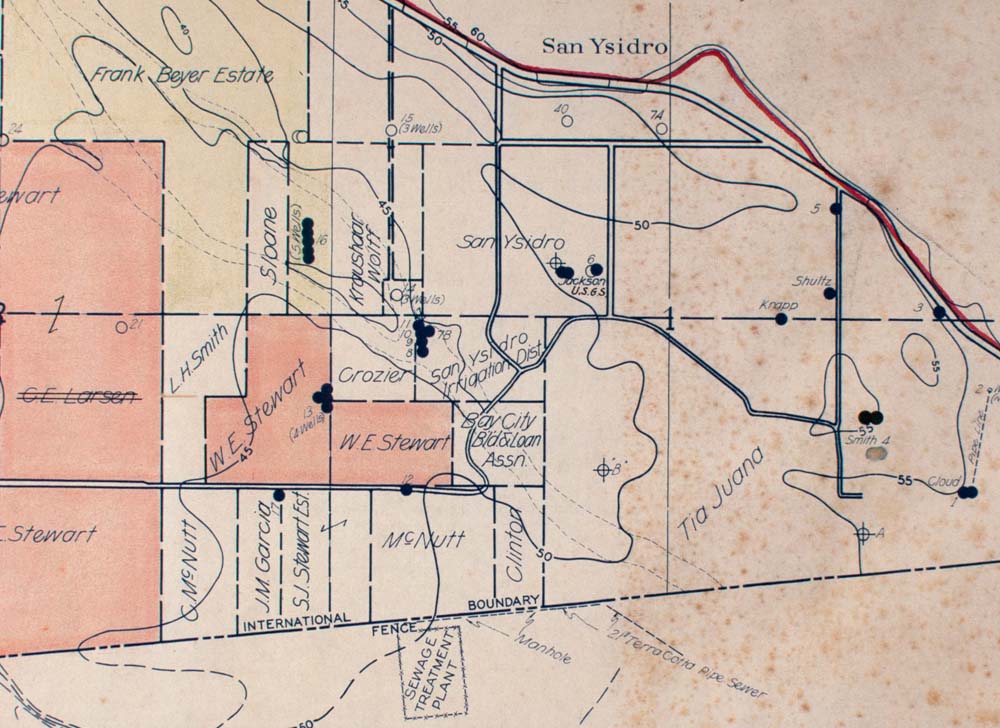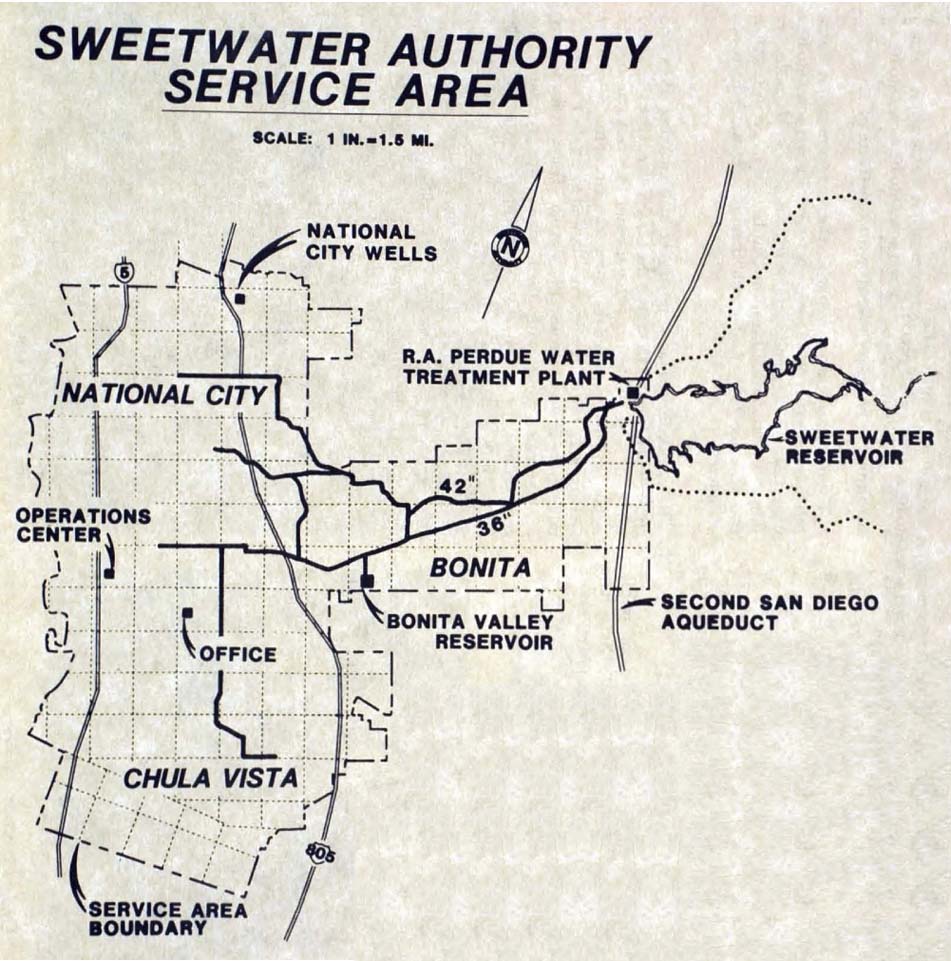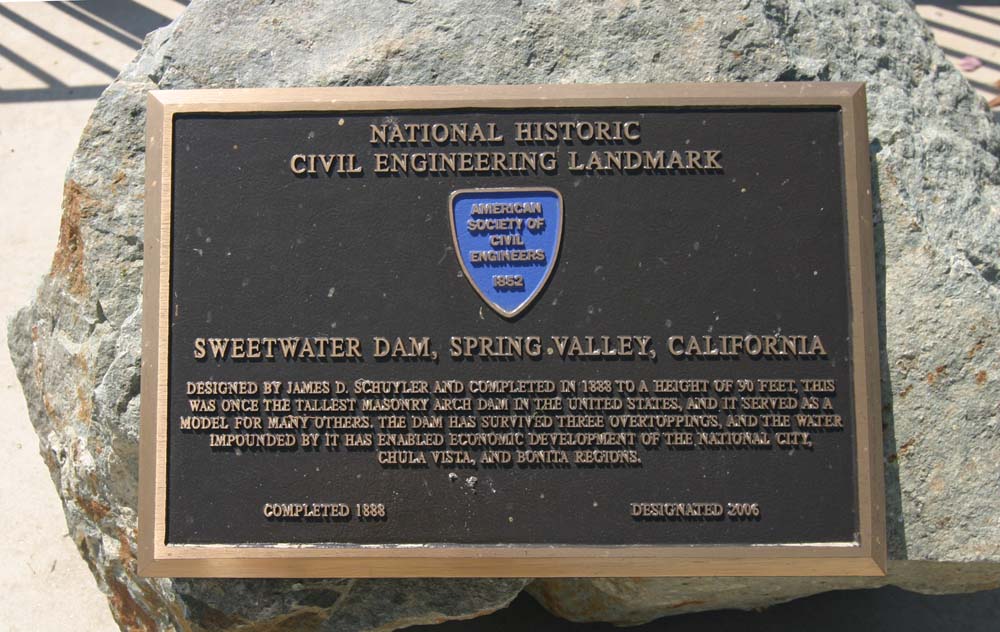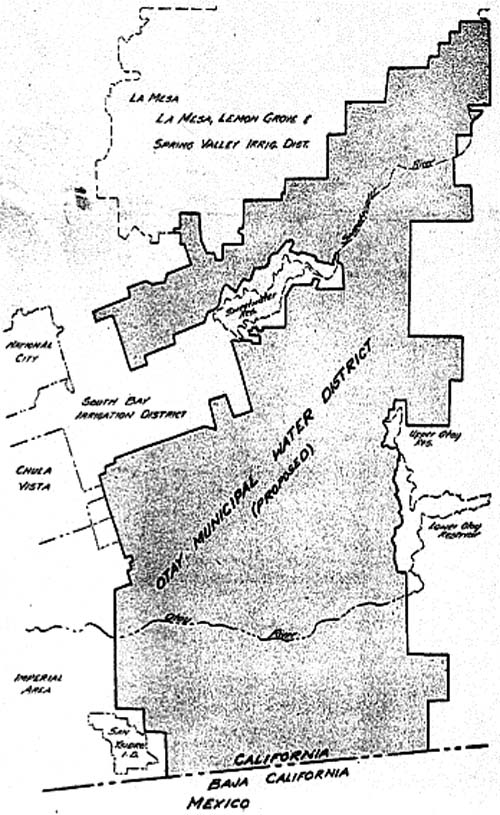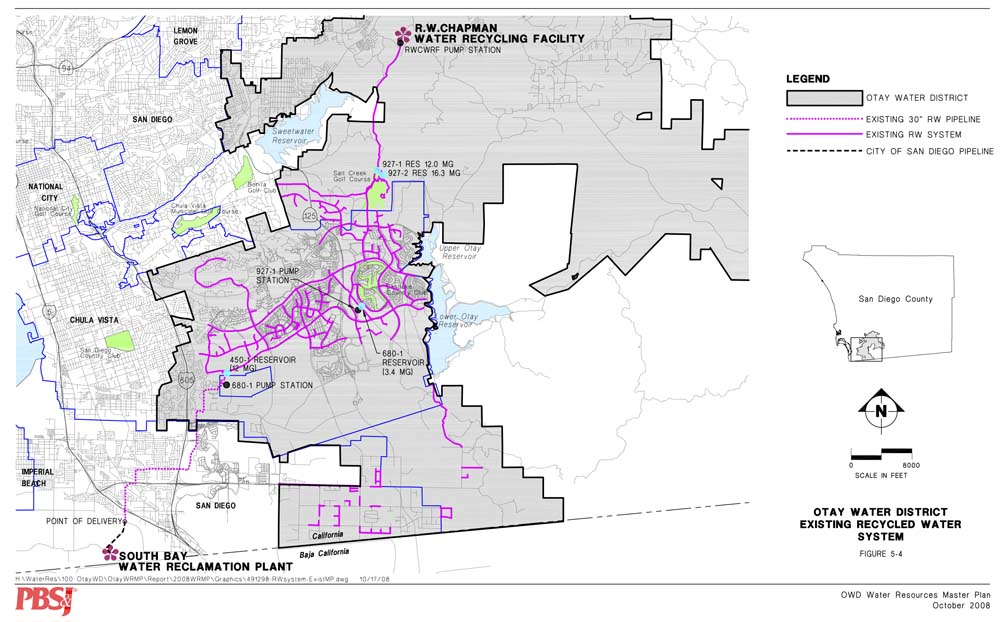|
Water Companies of the South Bay
The Lower Otay Dam in 2004
SAN DIEGO AND CORONADO WATER COMPANY
OTAY WATER COMPANYIn 1888 Babcock's water plans took a sudden change when he found a better water supply in the Otay River Valley. He had hunted and fished in the valley since his arrival San Diego from Indiana in 1883, and organized the Otay Water Company in 1886 to develop sources of water in the valley, including building a dam across the Otay River. The dam project stalled but his search for natural spring water in the Otay Valley found success in June 1888. He was able to reverse the flow of water through his Strand pipeline, sending Otay water north to Coronado instead of pumping San Diego River water south to Coronado Heights. The boomtown of Otay had been founded a year earlier, and its local newspaper reported "Great success! 30,000 gallons every 24 hours. Babcock & Story are piping water to their numerous possessions." The wells operated by the Otay Water Company pumped water into the pipelines of the San Diego and Coronado Water Company. This Otay water was marketed by Babcock as "Waukesha Water" and was bottled for consumer sales as well as piped to Coronado and new subdivisions of Coronado Heights and South San Diego.By July 5, 1888, the Otay Press reported "The big well in the Otay bottom is being successfully sunk and is now down 18 feet with plenty of water." By August 10, "The Otay wells are now yielding 800,000 gallons of water per day, supplying South San Diego and Coronado, and other localities along the pipeline." By Sept. 20, "The daily supply of water from the two big wells in the Otay is 500,000 gallons. In connection with the ten-inch water main from the wells, six-inch pipes are now being laid east of the Hotel Del Coronado a distribution through ten, six and four-inch pipes, instead of the ten and four-inch as they have been. This water supply is now, in the dryest time, proving to be bountiful and the quality is almost equal to the water in our mountain springs." By Oct. 3, "The people of Coronado speak in the highest terms of praise of the water they are now receiving from the Otay wells, and many of the guests of Del Coronado claim for it medicinal properties, several of them having been greatly benefited in health by drinking the water, and others have been cured of liver complaint and kindred diseases since its introduction as a beverage." ( Phillips, 1956. ) Dr. David Gochenauer, San Diego's Public Health Officer, noted in his annual report for the year ending Dec. 31, 1888: " I have given special attention to the water supply of that beautiful locality, and find that it will bear favorable comparison with any other of the celebrated waters. The Coronado Water Company recently discovered a series of living springs of pure water in the Otay valley, which is soft and pleasant to use, clear, bright and agreeable to the eye, and refreshing to the taste. This water has been piped to South San Diego, Coronado Heights and Coronado Beach; and the present supply, which can easily be doubled, already amounts to a daily yield of over 5,000,000 gallons. An analysis of this water, made by the eminent chemist, C. Gilbert Wheeler, of Chicago, gives the following result as compared with the celebrated water of Waukesha, Wisconsin; and an examination of this analysis will show that, while their medicinal properties are almost identical, there is but one-half the amount of organic matter in the Coronado water that there is in the Waukesha water." ( "First Annual Report of the Board of Health of the City of San Diego for the Year Ending December 31st, 1888.," The Journal of San Diego History 48 (Fall 2002). ) 1889/04/18 - There are now put up for market every week, 60,000 bottles of the Waukesha water from the Otay wells. (Otay Press, Apr. 18, 1889.) Ground has been broken for a Bottling Establishment near the hotel, by E. H Woodworth of San Diego, to bottle "Otay Mineral Water" ( Otay Press, Oct. 17, 1889. ) 1889/05/09 - Hotel Otay ad, uses the Otay Waukesha Water Exclusively (Otay Press, May 9, 1889.) 1889/09/28 - Babcock writes letter to F. E. A. Kimball: "Will you please say to the citizens of Coronado that we have commenced to run our pump at the Otay Water Works night and day, and that hereafter they will get no water but the choicest Coronado Mineral Water." ( Babcock letters, SDSU) 1889/10/10 - Pumps at Otay wells supplying 325,000 gals Waukesha water every 24 hrs. (Otay Press, Oct. 10, 1889.)
The "Coronado Natural Mineral Water" in this 1890 advertisement came from the Otay wells.
1890/03/13 - The pumps at the Otay wells are now running night and day, and two carloads of five-gallon demijohns filled with the mineral water were shipped direct from the wells to San Francisco this week. ( Otay Press, Mar. 13, 1890) 1893/02/20 - Work on Highland Reservoir near completion, will irrigate 600 acres southwest of the Otay river. The aerating table of the Highland reservoir at Nestor purifies Coronado water supply (The San Diego Union,Feb. 20, 1893, and Jan. 01, 1909;) The Highland 3,000,000 gallon steel distributing tank of the California American Water Company was built in 1964, a replacement of the open 1893 reservoir which first carried Otay water to Coronado. SOUTHERN CALIFORNIA MOUNTAIN WATER COMPANY
1894/10/15 - Gigantic blast tore out 100 tons of rock yesterday from side of mountain, and threw 100,000 tons of rock into the air, was witnessed by 200-300 people. Purpose of the blast was to obtain rock for the dam. In the narrow canyon scarcely 200 ft wide between mountains 80 ft high a tunnel had been driven into the southern hill a distance of 50 ft, diverging at that point into two forks, 20 and 30 feet long respectively. 8000 pounds of Judson powder at end of one fork, 4000 at other end. Dam site is 9 miles in the country. "The explosion was in charge of J. W. Hanson, representing the Giant Powder company. The dam will be built upon a foundation of masonry already laid from bedrock to a height of 30 ft. It will have a steel core covered with refined asphalt and two-inch plank bolted across. Each side of the dam will be braced by 160 feet of rubble. The dam will be 130 feet high, 220 feet wide at the base, with a width of 585 feet on top. The reservoir will have a capacity of 21.65m gals. Engineers Lew B. Harris and W. S. Russell have charge of the construction as well as that of the upper Otay and the Barrett dams already projected. (The San Diego Union, Oct. 15, 1894.) 1895/10/28 - Babcock built a ranch house at the lower Otay Dam. He brought guests from the Hotel del Coronado to hunt and fish on the Lower Otay Reservoir. ( Babcock letters, SDSU) 1900/12 - To get water to San Diego, the Southern California Mountain Water Co. began building a pipeline made of wood stretching from Otay to San Diego, with additional branch lines to supply farmers in the Otay Valley and residents of Coronado. In the early century, wood-stave pipes were the modern method for bringing water to cities. The first public water system in America had brought water to Boston through wooden pipes in 1652. Two-and-a-half centuries later, the technique was still state of the art. "It is common knowledge that wood pipe buried in the ground or kept saturated with water, has an indefinitely long life," noted the American Water Works Association in 1922. For the San Diego project, engineers designed 40-inch-diameter pipe made from Humboldt County redwood. The pipeline would run north from Lower Otay for 19 miles, ending at a reservoir being built at Chollas Heights. From Chollas the water would run four miles northwest through cast-iron pipes to the city filtration plant in University Heights at Howard Avenue and Oregon Street. There, the water would be aerated in a fountain before being piped to customers. Construction began in December 1900, when laborers from the Mountain Water Co. began building tunnels and trestles in preparation for the redwood pipe, which was being cured in Coronado. The contract for trimming the lumber into pipe staves went to the Russ Lumber Co. of San Diego. (The San Diego Union-Tribune, June 6, 2009.)
SCMW workers laying 40-inch wood water pipe from the Lower Otay ca. 1901 ( Mary C. Oswell collection, Bonita Museum )
1901/04/14 - Otay pipeline grade almost complete, from the dam to city of San Diego across foothills between Paradise Valley and South Chollas. The grade for the pipeline is over 3 miles to where the pipeline turns into the first tunnel which extends in a northwesterly direction toward Telegraph Canyon. The grade is largely in the form of a ditch 5.5 ft wide and 5 ft deep, goes across Telegraph Canyon to Sweetwater Valley to Bonita. (The San Diego Union, Apr. 14, 1901.) 1908 - Wood pipeline was laid from Lower Otay Dam through the Coronado "Y" connector in the Otay Rancho to the Highland Reservoir on Palm Avenue. In March, the Southern California Mountain Water Co. used this pipeline to supply Coronado and South San Diego with water from the Lower Otay Dam. (The Chula Vista Star, Nov. 29, 1951.) 1912/02/06 - The Southern California Mountain Water Co. signed a contract with the Coronado Water Co. to supply all the water needed for the city of Coronado. This water came from the Lower Otay Dam through the Coronado "Y" connector. (City of Coronado v. City of San Diego, Nov. 28, 1941) 1920/02/11 - City May Install Pump in Tijuana River. Having decided, following an Inspection of Tijuana river valley yesterday morning, that the city of San Diego may decide to use the river water as an addition to its water supply, a committee of city officials appointed by the city council to make the inspection yesterday instructed the city attorney to investigate the city's legal right to the water. The inspection trip of yesterday and the investigation ordered are a part of the city council's plan to make use of every possible addition to the city water supply. Those who made the trip were Hydraulic Engineer H. N. Savage, City Manager W. H. Judy and City Engineer Fred A. Rhodes. Members of the committee believe that It would be possible to pump 3,000,000 gallons of water daily from the sands of Tijuana river. City Manager Judy is investigating the cost of a pipeline from the river to connect with the city's Lower Otay pipeline, eight miles away. ( The San Diego Union, Feb. 11, 1920. ) Coronado Water Company No. 1 well map of Tijuana River Valley, May 10, 1921 - larger view (San Diego History Center)
LAND AND TOWN COMPANYFrank Kimball wanted to build a dam when he first saw the "Gorge of the Sweetwater" in 1868 after buying the National Ranch. But, like Elisha Babcock, did not have the means to construct such a massive structure. Instead, his Kimball Brothers Water Company supplied National City with water from local wells, hauled to homes and businesses by horse cart for 25 cents per barrel. When the Santa Fe Railroad was given part of the ranch in 1881 to bring the railroad to National City, it formed the Land and Town Company to build the dam and pipeline system to supply water to National City and to the new Chula Vista development of lemon orchards. The Sweetwater dam and reservoir was finished in April 1888.
Frank Kimball for many years supplied water to National City from wells, using such means as this water delivery wagon of F. T. Moore, shown in 1904
Sweetwater Dam under construction in 1887. (Photo from the Sweetwater Authority)
The Land and Town Company spent over $1 million on a pipeline system from the Sweetwater Dam to National City and Chula Vista.
Some of the pipes were made from redwood staves banded together. (Photo from the Sweetwater Authority) SWEETWATER WATER COMPANYIn 1902 the Sweetwater Water Company bought the water rights of San Diego Land & Town Company. In 1914 the Sweetwater Water Company was taken over by J. P. Morgan and Company of New York. In 1920 a group of local investors led by John Boal, under the name of the Sweetwater Corporation, hoped to sell stock of the water company to the public, but the shares did not sell. In 1927 the corporation was sold to a group of engineers led by Chester H. Loveland of San Francisco who built the Loveland Dam and reservoir. In 1935 the corporation was bought by the California Water & Telephone Company.
The Loveland Engineers, named for its founder Chester H. Loveland of San Francisco, bought the Sweetwater Water Corporation in 1927 and built the Loveland Dam
near Alpine 18 miles upstream from the Sweetwater Reservoir. It was finished July 17, 1945, and at 203 feet high, it doubled the capacity of the Sweetwater system. (Photo from Bonita Museum)
The Loveland Dam, shown here in 1945, was owned by the California Water and Telephone Company, the new name of the Loveland Engineers after 1935.
This company was sold to a Delaware group in 1966 and became known as the California Water Company. After an eminent domain lawsuit was won by the South Bay Irrigation District, the dams became a public utility in 1977, the Sweetwater Authority. (Photo from Bonita Museum) CALIFORNIA WATER & TELEPHONE COMPANYThis map of May 1934 was titled "General Map Showing Water Resources of The Sweetwater Water Corporation and Coronado Water Company." The Coronado service area is outline in red; the Sweetwater service area in green; the river valleys with water bearing sands are colored yellow. These areas became part of the California Water & Telephone Company in 1935. Note the locations of the Judson and Highland reservoirs and the Otay Wells discovered by Elisha Babcock. The red line down down to the small red square in the Tijuana River Valley marked the proposed well field development to supply the Judson Reservoir and the city of San Diego with well water. The pipelines from the Lower Otay Reservoir that carried water to the city of San Diego and to the city of Coronado divided at the Coronado "Y" in the center of Otay Rancho. (Map from Sweetwater Authority - larger view)
In 1935 the Sweetwater Corporation and the Coronado Water Company were purchased by a new holding company called the California Water & Telephone Company. This new company built the Judson Reservoir in 1937 to supply water to the growing subdivision southeast of Chula Vista. It also built a water plant in the Tijuana River Valley to pump well water to the Lower Otay pipelines for sale to the city of San Diego.
1936 - A water treatment plant for the new California Water and Telephone Co. was built west of Monument road, on north bank of Tijuana river, where 3 wells been drilled, 2 large 45-foot tanks constructed, served Palm City, Imperial Beach, Coronado, North Island, some going to Highland reservoir on south side of Otay for storage. ( Chula Vista Star, Jan. 27, 1939. ) 1936/03/13 - R. T. Guinn, prominent rancher of the Tijuana river valley announced mass meeting at Emory school to organize water users of the valley, protesting the pumping of 3 million gallons per day from the river by the California Water and Telephone Company. W. E. Stewart, large property owner in the valley, said the company should not be allowed to pump water out of the valley. ( San Ysidro Border Press, Mar. 13, 1936 ) 1936/03/27 - Tijuana valley ranchers met last night at Emory school to organize the Tijuana valley water users protective association. W.E. Stewart was elected president, and H. O. Brown, secretary. The board of directors are as follows: John S. Hull, Arthur, Reuther. O. G. Buehrer, R. T. Guinn and Henry George. It was agreed that the board of directors should charge for membership according to the number of acres owned by the applicant and in this manner funds could be raised quickly for legal aid in prohibiting the Coronado water company from pumping from the Tijuana river. Those present voted the board of directors the right to draw up by-laws for their new organisation to be submitted for approval this Friday evening, March 27 at 8 o'clock at the Emory school.A letter was read from Harold Conklin, deputy of water resources In Sacramento, which verified permits No. 3303 and 3304 to the water company which allocates them 3,200 acre feet per annum. Former Mayor Clark of San Diego was then introduced to the crowd. He gave a very interesting talk on the water situation of San Diego county. He said that he was opposed to draining the agriculture district of water for the city of San Diego. He also stated that when he was mayor of the city that the purchase of 60 or 65 acres of land in the river bottom was consummated to protect the ranchers from losing their water supply and saving it for the district. Mr. Clark advised the ranchers to take their case to court as had been done once before and he said, "you know folks, the Rio Grande river, the Colorado and the Tijuana rivers are all under the international water commission supervision and they should be consulted." Clark announced that he would be a candidate for superior court judge and expressed himself as in favor of the All-American canal for San Diego, stating that either we all prosper or none do. If San Diego city takes the water from the rural district for her populace, the ranchers will have to quit and then how will San Diego business prosper without the help of the outside districts. Mr. Clarke concluded his talk with a promise of helping where he could. Fred Jones of Palm City stated he understood water lines and valves were being changed and it was for the purpose of pumping Tijuana water to Coronado. A number of San Ysidro people were present including committees from the chamber of commerce of San Ysidro, the Ex-Service Men's club of the South Bay and the Imperial Beach improvement club. ( San Ysidro Border Press, Mar. 27, 1936. ) 1937/02/05 - Valves opened Tuesday to start filling Judson dam at rate of 1 million gallons per day, for 212 million gallon capacity, will cover 38 acres, and dam face is 60 feet deep, built to maintain pressure locally, will not be put to use until June. ( Chula Vista Star, Feb. 5, 1937. ) 1938/12/16 - A new water trunk line from Sweetwater Dam to Judson distribution reservoir at 4 million gals daily. The line is an 18-inch pipe 8500 feet long that "jogs along Fifth and Sixth Aves, and cuts across country club property." Capacity of Judson is 212 million gallons. Another pipe 8-inch, 3200 ft, cast iron cement lined, was laid along Second Ave south to M Street. ( Chula Vista Star, Dec. 16, 1938. ) 1939/02/15 - Mr. T. B. Cosgrove in a letter enclosed copy of communication from the Division of Water Resources relating to the hearing of the California Water & Telephone Company regarding the diversion of Tijuana Valley water to the Judson Reservoir, which hearing has been postponed until certain issues involved are settled by the Superior Court of San Diego. ( Chula Vista City Council Minutes, Feb. 15, 1939. ) 1939/03/15 - The city of San Diego within two weeks will file an answer to the suit brought by the city of Coronado in a water controversy. Dayton L. Ault, city attorney, announced yesterday. San Diego, though a defendanct in the suit, is chiefly interested in seeing the litigation concluded and the rights of all parties settled, Ault said. A demurrer to the suit filed by the other defendant, the California Water and Telephone Co. was over-ruled in Judge Arthur L. Mundo's superior court Monday. In the demand for declaratory relief, Coronado contends that it has an equitable interest in waters from Otay reservoir by reason of long and continued usage. It is asking that this interest be clarified and that the water company be directed to furnish Coronado with water from the reservoir rather than from wells in the Tijuana river valley basin. Ault said the suit had its inception in old contracts between the two cities and with various water companies, under which, in the past, the city of San Diego sold $80,000 worth of water a year to Coronado consumers through a distribution company which served the area. He said that since the present company, California Water and Telephone Co., started delivering the well water three years ago. it had purchased only $4000 worth of water a year from San Diego and this city was put in the position of maintaining only a standby service for Coronado. He said he regarded the suit as a friendly one designed to determine the rights of all parties. (The San Diego Union, Mar. 15, 1939.) 1941 - The city of Coronado won its lawsuit against the city of San Diego, restoring the contract of 1912 by which the city of San Diego agreed to supply water to Coronado through the Coronado "Y" pipeline connection. The Coronado Water Company and its current owner, the California Water & Telephone Company, were allowed to continue to obtain water from the Lower Otay Reservoir despite the city of San Diego taking water from the Tijuana River Valley wells. (City of Coronado v. City of San Diego, Nov. 28, 1941) 1943/09/16 - Members of the city attorney's staff yesterday were preparing to bring suit to make certain that the city's rights to water of Cottonwood creek and other tributaries of the Tijuana river north of the international border are not impaired by a recent court decision. Litigation between the California Water & Telephone Co. to determine riparian rights in the Tijuana river valley below San Ysidro resulted a few months ago in a decision that had been reported open to a possible interpretation that the private utility may claim water rights purchased by the city from the Southern California Mountain Water Co. in 1912. If the new decision were interpreted adversely to the city's interests. J. F. DuPaul. city attorney, has told councilmen, opportunities for construction of a Marron canyon dam and further development of Barrett reservoir might be impaired. The waters of the upper stream were not involved directly in the recent litigation, but the city has been advised that every precaution is advisable. The proposed litigation will take the form of a quiet title suit. (The San Diego Union, Sept. 16, 1943.) 1947/07/09 - There has been no contempt on the part of the California Water and Telephone Co., by pumping water from its wells in the Tijuana River Valley,. T. B. Cosgrove, of Los Angeles, water counsel for the City of San Diego, argued yesterday. Cosgrove was appearing on behalf of the City and as friend of the court, before Superior Judge James O. Moncur of Plumas County, here to consider contempt charges brought against the water company by farmers of the Tijuana River basin. Cosgrove informed the court that if the company should be restrained from pumping from its wells the City of San Diego would be obligated to provide the City of Coronado with more than 2 million gallons of water daily. That city is at present supplied by the water company. Judge Moncur announced late yesterday, after listening to arguments for two days, that he will announce this morning his ruling on the demurrer of the water company, interposed in opposition to the contempt proceedings brought by the farmers. (The San Diego Union, July 9, 1947.) 1951/11/29 - Sweetwater division of California Water and Telephone Co. is replacing Otay wood pipeline with 15-inch cement-lined welded-steel pipe, just finished 8000 feet from Otay Valley west, added to 6000 ft placed into service 1950, now about half done replacing the 5.5 miles of 20-inch wood pipe, according to Al Pouter. New pipeline delivers water to the Highland Reservoir and to Coronado. The old pipe was laid in 1908, laid above ground, made of two thicknesses of wood staves held together with steel tension bands. a section has been given to the San Diego Historical Society for the Serra Museum. ( Chula Vista Star, Nov. 29, 1951. ) In 1964 California Water and Telephone was acquired by General Telephone and Electronics Company. Two years later a Delaware company, American Water Works Service Company Inc., "the largest investor-owned system of its kind in the country," bought the water company, along with several other systems, for $41 million (the cost for the Sweetwater system was $14.9 million). Operating as a subsidiary of American Water Works, the local water company was now called California American Water Company. (Trook, 1988, pp. 18-19. )
Cal Water Service Area Map of San Diego District. June 12, 2012 online
SAN YSIDRO IRRIGATION DISTRICT
Little Landers in the October 1914 Popular Mechanics magazine.
In 1908, William E. Smythe, a renowned leader of the national reclamation movement and George P. Hall, former Chairman of the California State Board of Horticulture, selected the site of Belcher Ranch in the Tia Juana River Valley as the location for the Little Landers agrarian community. Itwas modeled after Smythe's principles of cooperative farming and agricultural utopian ideals, popular throughout the country in the early 20th century in response to the industrial revolution and cramped conditions of urban living. Smythe's concept included owning a residential town lot and at least an acre of agricultural land. The motto of the settlement "A Little Land and a Living" espoused the idea that a family could earn a livelihood from cultivating an acre of land. In addition, the proximity of Little Landers to the City of San Diego was emphasized as a market to sell the colony's produce. Formal incorporation of the Little Landers Corporation occurred on August 1, 1908 and their holdings increased to 550 acres later that year. Smythe purchased 550 acres of the ranch, including 150 acres along the valley floor, 400 acres along the hillside, and the farmhouse itself, for $15,000 from Belcher. The valley floor contained about 150 acres while 400 acres lay along the adjacent mesas. Lower level lands were valued for their fertile soil and access to water. Smythe announced the corporation's plans to grade the area, install sewage and water lines, in addition to constructing park facilities. Within a few weeks of opening day in June 1909, twenty families were living in Little Landers. Many came from the East Coast, where San Ysidro's warm climate and agrarian lifestyle was touted in promotional materials. Though ideally, Smythe's residents would have some knowledge and experience with farming or gardening, the agrarian lifestyle ultimately appealed to a number of aging and retired urban dwellers who hoped to find a quieter and simpler way of life on the Mexican border. (Lee, 1975, and Historic Context Statement, 2010.) 1911 - Though Little Landers enjoyed success through 1909, by 1910 financial problems and lack of adequate irrigation caused the corporation to go bankrupt. Only thirty-eight families remained in Little Landers by the fall of 1910 and few of the settlers who had purchased land had constructed homes. The greatest difficulty to settlement was the availability of water. While a reservoir was dug at the head of Mesa Avenue and piping was laid, irrigation could not be provided to all settlers. Those who were attempting to farm land on the mesas struggled more than those who had settled down by the Tia Juana River. Thus, the irrigation issue likely discouraged people from purchasing and cultivating land further from the river. In December 1910, the formation of a new corporation, Little Landers, Incorporated, led to the organization of the San Ysidro Irrigation District. With the new corporation, new sales practices were instituted and the requirement to purchase a lot in town plus farm acreage was abandoned. As a result, more people were encouraged to simply purchase a residential lot, which promoted continued development of the platted town sites. Between 1911 and 1912, the community focused on efforts to create an irrigation district. C.S. Alverson, a former city engineer, designed a new water system that would deliver water to each lot. A pumping plant was built in 1913 at the end of Cottonwood Road. The new system promoted development not only of the agricultural areas down by the river and the residential lots in town, but also the cultivation of the mesas that were previously unserviceable. With a reliable water system, the population of Little Landers increased to three hundred. According to Smythe's promotional article, "Quest of the Fortunate Life," which he wrote for West Coast Magazine in June 1913, forty-seven homes were built in 1912. (Historic Context Statement, 2010.)
Well Map Tia Juana Valley in Sept. 1937, compiled under supervision of Charles H. Lee from the California State Division of Water Resources.
The large number of black dots clustered in the river bed in San Ysidro represent the water wells under the jurisdiction of the San Ysidro Irrigation District. (San Diego History Center) 1936/10/10 - San Ysidro is the trading center for a large area of fertile and well irrigated agricultural land. The irrigation district is supplied by wells sunk in the Tia Juana river bed and the water is distributed through 12 miles of water mains. The district was organized in 1911 and has reached the financial status that it no longer uses water meters. There is plenty for all. It boasts that it is in better financial condition than any other similar district in the state. ( The San Diego Union, Oct. 10, 1936. ) 1957 - When San Ysidro incorporated San Diego, San Diego took the library and the Civic Center. They gave us 10 acres of our Irrigation property for Larsen Sports Field. When the San Ysidro Irrigation District was developed down in the river bottom (Larsen Sports Field is now located at the site of the community-owned pumping station area) the community was in excellent shape and the San Ysidro Irrigation District Office was added to the park. Later a small office was built down beside Tia Juana Blvd., which was changed in 1926 to San Ysidro Blvd. ( Chula Vista Historical Society Bulletin, June 1988. ) TIA JUANA VALLEY COUNTY WATER DISTRICT1946/01 - The Tia Juana Valley County Water District was created by an act of the State Legislature in January 1946 and currently lies entirely within the boundaries of the City of San Diego. The District follows the westward flow of Tijuana River (the Spanish name of the river flowing westward through the District) from its entry into the United States at San Ysidro into the river estuary to the Pacific Ocean. The district comprises an area of approximately 5.1 square miles within the City of San Diego. A five-member board of directors manages the District. A general manager conducts daily operations. The residents of the District elect the members of the board of directors for a four-year term. Two members are elected in one even numbered year and three members are elected two years later. The District raises funds by an annual assessment of $50 per parcel of real property lying in the District. Additional monies have been received from various grants. In 1995 two wells were drilled on the north side of the Tijuana River to determine if there was any usable water in the aquifers. No usable water, in commercially adequate amounts, was found. During the passing of the years, the District functions have been absorbed by the City of San Diego. The City of San Diego now provides water and sanitation services for the District residents and property owners. The 1999-2000 Grand Jury found the District to be insolvent; that is, liabilities exceed assets. The District was dissolved in 2004. (San Diego County Grand Jury Report, 2003)1989/11/07 - Candidates hope to pump new life into water district. Matt Marschall is a candidate today for election to a board that may not exist a few months from now. South Bay's tiny Tia Juana Valley County Water District has announced plans to disband. But that hasn't stopped Marschall and two others from forcing the first-ever elections in the 50-year existence of the district. Marschall and father-son team Floyd Worthlin Sr. and Floyd Worthlin Jr. are challenging incumbents Robert Bonner and James Jackson for three open seats on the board. (The San Diego Union, Nov. 7, 1989 ) 1989/11/09 - Trio swept into office hope to save a tiny South Bay water district. A slate of three candidates running for the board of the Tia Juana Valley County Water District was swept into office Tuesday, unseating two incumbents and forging a majority that could reverse plans to disband the district. Matt Marschall, Floyd Wirthlin Sr. and his son, Floyd Wirthlin Jr., captured a majority of the 342 ballots cast for the three seats open on the board of the tiny South Bay water district. Marschall finished with 241 votes, Wirthlin Sr. with 222. (The San Diego Union, Nov. 9, 1989 ) 1998/10/31 Hopefuls seek end to water district 3 vow to dissolve agency if they win. A slate of candidates running for election to the Tijuana River Valley County Water District board wants to liquidate this tiny water authority because it believes the agency has become irrelevant and costly. The slate: community activist David Gomez, his wife, incumbent Jeanie Gomez, and Martha Alicia Navarrete, a Nestor resident has signed pledges to immediately dissolve the water district. If all three candidates are successful, they will have a majority on the five-member board. Talk of doing away with the 52-year-old district has become the dominant theme of this election. Two current board members, and at least one incumbent seeking re-election, reject the notion of closing down operations. "David (Gomez) is a political loose cannon," said water board candidate Nick Inzunza. "It is ludicrous for him to talk of getting rid of the district which represents about 15,000 people." Unlike other county water districts, the Tijuana district sells no water. It exists to find and develop new water resources in the South Bay, and to advocate on such issues as flood control. With fewer than 6,500 registered voters, the district runs from the border north to Imperial Beach's Ream Field and east to Interstate 5. The six candidates for the water board are: David Egger, 37, who owns a farm and horse ranch and is a former board member who lost a 1996 re-election bid. His grandfather, Robert Egger, a Swiss dairyman, drilled the first documented deep well in the river valley. Nestor residents David Gomez, 58, of the grass-roots group Citizens Revolting Against Pollution, and his wife, Jeanie Gomez, 43, who was elected to the board in 1996. The couple run a river valley horse ranch. The citizens group was formed in 1990 to combat pollution in the valley and has branched out to community activism. Incumbent Inzunza, 56, brother of board president Gilbert Inzunza, a school psychologist at Lincoln Acres elementary school. Inzunza was appointed to fill out the unexpired term of Danny R. Marschall, who died in February. Navarrete, 47, a member of Citizens Revolting Against Pollution. Incumbent Carolyn Powers, 53, an aide to state Sen. Steve Peace, D-EI Cajon. Powers was first elected in 1994. This is not the first time there has been talk of dissolving the district; it was attempted in 1989 and in 1996. The Tijuana water district was on the verge of disbanding in 1989 when a new board majority won office and started generating interest in local water issues. Officials note that the water board cannot easily disband. It would have to apply to the Local Agency Formation Commission, which would make a recommendation to the county Board of Supervisors. The supervisors could approve the recommendation or order a districtwide vote. David Gomez said the water authority's time has passed. "It was a good water district when it was used by farmers to protect the water in the valley," Gomez said. "They are not doing that anymore. The board needs to look into reality and stop using taxpayer money." The two other candidates on the slate, Navarrete and Jeanie Gomez, agree. Members of the dissolution slate also are critical of the district's $50 per property annual assessment. Navarrete said, "The most aggravating thing is that they are taking taxes out of our property." Incumbent Nick Inzunza said he believes people in the area "need a voice, someone to speak up for us," on issues such as placing large sewage treatment ponds in the valley. "We in the valley don't want ponding, and we have taken that position," Inzunza said. "Ponding is an example of how a larger jurisdiction can impose their will on the river valley. And, we feel we are imposed upon." The water board has been successful on several fronts, he said. It has been an advocate for flood control measures. And it has found new water resources. The district tested to depths of about 1,000 feet and found that there is a limited amount of available drinking water at that depth, according to district consultants. The quality of water is excellent and requires very little treatment to meet drinking water standards. It remains to be seen, however, whether the district can economically convert the deep well water into drinking water. Powers, a civic activist concerned with water issues, said she is proud of her four years in office and of the board's efforts to find new water resources. She is critical of the amount of money the board is spending but is against disbanding the district. "I don't see that we would benefit from the county taking over the leadership" in the river valley, she said. David Egger is against making a hasty decision. "I want to reduce expenses, pay down the debt and then we need to figure out if there is any need for this water district," Egger said. "I've had a lifetime of experience dealing with water quality, wells and sewage flows." The Tijuana River Valley is probably best known in the region for border crossing attempts by undocumented immigrants, an occasional flood and waves of raw sewage that foul the county's southernmost beaches. But water officials say the valley is also one of the few remaining wetlands in the United States and has a rich agricultural heritage that must be protected. Once the Tijuana Valley area was as lush and green as a golf course, where farmers grew vegetables, dug wells and irrigated their land with ground water. In the 1950s, about 80 percent of it was farmed, but in the 1960s, salt water and sewage from Tijuana began contaminating the water table and ruined wells. Finally, after the 1980 flood, which did millions of dollars in crop damage, many farmers relocated. The few farmers who remain in the valley today use private wells that have not been contaminated or buy water from San Diego, which is expensive. (The San Diego Union-Tribune, Oct. 31, 1998.) 2000/10/28 - Race may decide future of waterless water district. The Tia Juana Valley County Water District may be small, but the upcoming election could have an enormous impact on the future of the 54-year-old district. Two candidates are running with the stated goal of disbanding the district, which provides no water, but still collects $50 annual fees from 3,559 property owners. The seven-square-mile district includes the Tijuana River Valley and parts of Nestor and San Ysidro. (The San Diego Union-Tribune, Oct. 28, 2000. ) 2002/07/26 - The Tijuana Valley County Water District has hired former congressman Brian Bilbray to help the district obtain more than $1 million for a ground water exploration project. The board of directors voted Tuesday to pay Bilbray several thousand dollars over the next few months to lobby for them in Washington, D.C. Their goal is to have the California Affordable Quantity and Quality Water Act, soon to be introduced by Sen. Barbara Boxer, passed by the House of Representatives. (The San Diego Union-Tribune, July 26, 2002 ) 2002/08/23 - The most remarkable thing about this year's Tijuana Valley County Water District election is that there won't be one. The three incumbents get to keep their seats because there are no challengers -a novelty in a district that has suffered through years of contentious elections in which the incumbents got tossed out more often than not. "I think the community more or less is saying, 'You guys are doing all right and we're not going to bother you any more,'" said board president David Gomez. "It's kind of nice really." Gomez was elected in 1998, defeating incumbent Carolyn Powers. Two years ago his brother, Amando, joined him on the board after a bitter election in which the two other incumbents were defeated. Those two, Gilbert Inzunza and Raul Arzola, had defeated the previous incumbents to win their seats in 1996. Together the Gomez brothers promised to close the district, which collects assessments from residents, yet provides no water service. The city of San Diego or the California-American water company provide water to the residents, and the annual $50 assessments pay for the water district's office expenses, one full-time employee and stipends to the board members. But things have changed on the board since the last election. For the first time in years, the members seem to be getting along. "I was always upset with the district," David Gomez acknowledged. "But now I'm satisfied with what I'm doing, representing the South Bay." Gomez said the board acts as the public voice of the residents of Nestor and the river valley when water issues come up that affect them, such as flooding, or pollution from Mexican sewage that crosses the border via the Tijuana River. David Egger, a longtime incumbent who lost his seat in 1996, only to regain it in the next election, said he thinks the district is finally doing something worthwhile. The district is applying for federal funds to do ground-water exploration, with the hope of producing reclaimed water, or using the valley's underground aquifer for water storage. "As long as we are producing something and I feel that the district is constructive and beneficial to the constituents, I will stick with it," Egger said. The water district was founded in 1946 by a group of ranchers, including the Egger family, to protect the water rights of the farmers. Board membership stayed within a few families, and there were no election challenges until 1989. That fall the board decided the district had lost its usefulness and planned to disband it. They voted unanimously in late October to donate the district's entire $1.5 million treasury to the county to buy land for a public park in the river valley. Two weeks later, three new board members were elected, and the new majority was determined to keep the district open. They tried to get the money back but couldn't, and the district has never quite recovered financially. Two years ago a county grand jury investigation called the district insolvent, and questioned its accounting practices. Incumbent Nick Inzunza said the district has managed to rehabilitate its public reputation in the last couple of years by partnering with some high-profile politicians on projects such as construction of a flood-prevention berm and the cleanup of a stagnant pool of polluted water. One of the politicians they've been working with is Inzunza's nephew, San Diego City Councilman Ralph Inzunza Jr. "We've been able to get some things going," said Nick Inzunza. "We've just been like a catalyst, you might say, because we really don't have any money ourselves." "We're comfortable with each other now, and we've developed a lot of connections with people who could be influential in moving things along in the valley," Inzunza said. (The San Diego Union-Tribune, Aug. 23, 2002.) 2004/07/10 - Tiny water district won't just go away. Tijuana board opposes LAFCO. Nearly 60 years after the Tijuana Valley County Water District was formed to protect the water rights of farmers, a county commission is poised to pull the plug on the district, which is accused of misusing public funds. The Local Agency Formation Commission, or LAFCO, is scheduled to vote Monday on whether to dissolve the district, putting an end to a water district that has never provided any water to its constituents. The 16-square-mile district is just north of the border. (The San Diego Union-Tribune, July 10, 2004. ) SOUTH BAY IRRIGATION DISTRICT1944/06/09 - San Diego County Water Authority formed (SDCWA). According to William H. Jennings, a lawyer active in local water projects for many years, the San Diego Chamber of Commerce in 1934 or 1935 "formed a group to discuss ways and means of importing waters. . . ." Their discussion led to the passage by the State Legislature, in 1943, of the County Water Authority Act, which authorized the formation of the San Diego County Water Authority, an agency formed to supervise the distribution of Colorado River water. Chula Vista and National City voters approved the proposition to join the San Diego County Water Authority, and on June 9, 1944, the water agency was formed. Coronado joined its South Bay neighbor cities as one of the nine original members of the County Water Authority but withdrew a short time later. With the Navy's assistance, the San Diego County Water Authority persuaded the Government to revive the southern aqueduct extension project halted near end of WWII. Construction began on September 12, 1945. On December 11, 1947, less than two years and three months from groundbreaking, water began flowing from the portal of the San Jacinto tunnel in Riverside County down to San Diego's San Vicente Reservoir. Five months later, on May 5, 1948, the 16.3 mile La Mesa-Sweetwater extension, from San Vicente to the Sweetwater Reservoir, was also completed. It cost $1,362,00 and doubled the available water supply of the Sweetwater system. (Later, a second aqueduct was constructed. Completed on May 6,1960, it crossed the river gorge and passed west of Sweetwater Dam and within several hundred yards of the planned water treatment plant at Sweetwater Reservoir. The second aqueduct provided direct service from the Los Angeles Aqueduct to the reservoir, eliminating the need for the La Mesa-Sweetwater Extension.) ( Trook, 1988, p. 15.)1948/02/27 - Chula Vista and National City have signed water contracts with California Water and Telephone Co., will purchase water from the County Water Authority at $12 per acre foot, local rates to increase 11% ( Chula Vista Star, Feb. 27, 1948. ) 1948/05/05 - The arrival of Colorado River water via the La Mesa-Sweetwater Extension in 1948 was celebrated at a ceremony held at the Sweetwater Reservoir on that May 5th day. (Truly celebrated because the Sweetwater system, during the construction of the extension, had been receiving emergency water supplies from the City of San Diego.) One hundred and fifty men gathered to hear about the promised bounty more water would bring. National City Baptist minister Watson Brown's dedication speech set the tone by starting off with the Biblical passage, "The desert shall be filled with springs of water, and the valleys shall blossom as a rose." The highlight of the day occurred when the mayors of National City and Chula Vista joined hands to open the valve to start water flowing through the pipeline. (San Diego Daily Journal, May 6, 1948) 1951/03 - South Bay Irrigation District formed. The SDCWA built the San Diego Aqueduct from Riverside County down to San Diego's San Vicente Reservoir in 1947, and the La Mesa-Sweetwater Extension from San Vicente to the Sweetwater Reservoir in 1948. But the residents of the Sweetwater Valley had been left out. They were not entitled to the Colorado River water because they did not live in either Chula Vista or National City. Therefore, to accommodate the water needs of the growing population in this rural, agricultural area, the city of Chula Vista agreed to assign its water rights to a new organization: the South Bay Irrigation District (SBID). Organized in March 1951, the South Bay Irrigation District included Chula Vista and the unincorporated area of Sweetwater Valley. ( Trook, 1988. ) 1953/03/05 - Fred Stafford elected president of South Bay irrigation District, succeeding W. Ray Coyle ( Chula Vista Star, Mar. 5, 1953. ) 1954/03/18 - Sweetwater Co. installed new automatic chlorinator at the Sweetwater Dam. manager A. J. Poulter. Chlorine has been used in city water supplies since the 1910 experiments of Dr. Carl Darnell of U. S. Army Medical Corps. ( Chula Vista Star, Mar. 18, 1954. ) 1956/02/09 - South Bay Irrigation District begins process to buy the Sweetwater division of the California Water and Telephone Co. ( Chula Vista Star-News, Feb. 9, 1956. ) 1957/11/28 - first of 4 giant water tanks being constructed to replace Judson reservoir, are located just north of the east end of Oxford St. ( Chula Vista Star-News, Nov. 28, 1957. ) 1960/02/21 2nd aqueduct pipe being laid across the Otto Rollin dairy farm in Sweetwater Valley (photo) and will follow Proctor Valley Road to Otay Lakes ( Chula Vista Star-News, Feb. 21, 1960. ) 1960/05/06 - A second San Diego Aqueduct was built to carry more water into San Diego from the north. ( Trook, 1988. ) In April 1961 the Sweetwater Filtration Plant was completed next to the Sweetwater Dam and dedicated Sept. 7, 1961. ( Trook, 1988. ) SWEETWATER AUTHORITY
Map of Sweetwater Authority (Trook, 1988, p. 14)
1968/05/10 - On May 10, 1968, the South Bay Irrigation District filed suit of eminent domain to acquire the Sweetwater system of the California American Water Company. National City was finally ready to abandon it's go-it-alone stance and, on January 28, 1969, joined the suit. A lengthy trial commenced in November of 1971. It was not settled until May of 1977. The main dispute was over determining just compensation to California American Water Company for the system. Superior Court Judge James Focht's determination, in 1973, of $14,484,000 as the August IS, 1969, value of the water company did not satisfy the company's owners. They estimated the worth of the company's holdings at close to $50 million. The $35 million disagreement led the water company first to the Court of Appeal and then to the California Supreme Court, which denied the company a hearing. ( Trook, 1988. ) 1972/02/03 - Sweetwater Authority formed as a public utility with 5 board directors from South Bay Irrigation District and 2 from National City. General Manager Garry Butterfield took over operation of the water system Aug. 30, 1977. Lloyd Lee of South Bay Irrigation District was "patriarch of the board" for 30 years (plaque on Sweetwater Authority patio). David Burns was South Bay Irrigation District board member who helped create the Sweetwater Authority. ( Trook, 1988. ) 1976 - Feather River water from the State Water Project water blended with Colorado River water in 1976. This river water raised danger of bacteria in the Sweetwater Reservoir that had been mandated as a recreation area. This led to the eventual expansion of the filtration plant by May 1987 (with new name of Robert A. Perdue Water Treatment Plant). It also led to the construction of the Bonita Valley Reservoir with 19 million gals. capacity, which was an underground concrete structure completed in 1985. ( Trook, 1988. ) 1977 - Believed to have been the "biggest water utilities case ever tried in California courts . . . and the biggest single property condemnation suit in county history," according to a June 1972 edition of the Chula Vista Star-News, the Califomia American case ended the 50 year, on again, off again, battle for public ownership. To avoid the expense of a second trial. the company negotiated a settlement. It would now be up to the voters to decide if they wanted to own the system. On May 31, 1977, an election was held to authorize the $22.5 million worth of bonds needed to buy the water company. Judge Focht's original $14 million award had been increased to $19,036,000 because of the inflationary time lapse between the 1969 valuation and the 1977 negotiation. Operating funds and reserves accounted for the extra $3.5 million.) The combined efforts of National City's civic leaders and the South Bay Irrigation District convinced just enough voters, and the bond issue was narrowly passed by a vote of 9,653 to 8,078. The local headline read . . . That Water You're Drinking . . . You Really Own It -- Chula Vista Star News, September 1, 1977 ( Trook, 1988, pp. 18-19 ) 1978/02/12 - Sweetwater Authority has new logo, no longer will use the Cal-Am logo it inherited when it took over the water company. ( Chula Vista Star-News, Feb. 12, 1978. ) 1984/05/03 - Sweetwater Authority moved from Third Avenue to their new $868,000 office building on Garret Avenue. ( Chula Vista Star-News, May 3, 1984 ) 1986/12/18 - The Sweetwater Authority dedicated the 18.7-million-gallon Bonita Valley Reservoir. Partially financed from savings achieved from use of local water and completed in 1985, the reservoir nearly doubled the amount of stored, treated water available in the water system. An underground concrete structure with two feet of earth on top, the Bonita Valley Reservoir, says Butterfield, "improved the reliability of the system and provided an emergency supply of water to the western part of the system," The filtration plant itself was, by May 1987, refurbished and expanded to meet the water quality standards that had been established by the public health department in 1978. Eight million dollars worth of improvements included a new main control room and water laboratory, and sedimentation basins to remove suspended matter from the water before filtration. (All these improvements were made without interruption of the services of the water treatment plant.) Along with a physical facelift and expansion, the plant was dedicated under a new name - the Robert A. Perdue Water Treatment Plant. Perdue had been the Superintendant of Water Quality from the inception of public ownership in 1977 to his death on November 3, 1985. "His death," said Butterfield, "left a big hole in the organization." Perdue had been involved in the design and construction of the plant from the beginning and had worked hard to insure that the facility included all the necessary features to deal with variations in raw water quality. After Perdue's sudden death at age 39, before the plant's completion, the board, recognizing the role he played in the filtration plant's construction, dedicated the plant "not only in his memory but in his name," ( Trook, 1988, pp. 20-21. )
The Sweetwater Dam's 100th anniversary was Apr. 24, 1988. It was dedicated as a National Historic Civil Engineering Landmark by the American Society of Civil Engineers in 2006.
1999/10 - In the early 1990s, Sweetwater Authority began preliminary design and planning studies for the installation of a facility to remove minerals and salts from the brackish groundwater. The first phase of the Sweetwater Authority Groundwater Desalination Facility was dedicated in October of 1999. The facility produces four million gallons of potable water daily for the water system. Studies of the operation of the facility and of new technology have been performed and it is now possible, with the use of the latest reverse osmosis membranes and other new technology to increase the capacity of the desalination facility to 10 million gallons per day at a savings in power cost per unit. The initial plant was designed to leave ample room to double the capacity of the facility. This doubling of capacity will be accomplished with an additional 25 percent increase in production and the bonus of a power savings from the upgraded and expanded facility at the present site. Brackish groundwater has proved to be a viable water source given the proper treatment. The Authority is looking at a similar future plant on the Otay River in partnership with the City of San Diego and Otay Water District and perhaps others. In the event that there are future needs for large quantities of ultra-pure water for industrial purposes, Sweetwater could provide ultra-pure water for industrial or other uses to a defined service area like an industrial park if it were properly sited. ( Reynolds, 2008, p. 24. ) 2006/04/07 - Sweetwater Dam to be national landmark. Rugged mountain ridges serve as the backdrop for the steep, arched Sweetwater Dam, which stands 127 feet tall and is marking its 118th year. In a ceremony today, the American Society of Civil Engineers will officially recognize the dam as a National Historic Landmark. The dam stores water for more than 177,000 residents in National City, parts of Chula Vista and the unincorporated area of Bonita. It was once the tallest masonry arch dam in the United States and is one of 15 dams worldwide that have been designated historic. Construction of the original dam began in November 1886 and was the dream of land mogul and National City founder Frank Kimball. The innovative design included a 50-foot, arched dam. "This was a radical idea," said Jim Smyth, director of engineering for the Sweetwater Authority, which oversees the dam's operation. "An arch concept was not at all common in that era." That has changed over the past 100 years. Engineers now use the arch as a standard design because of the strength it provides. A few months into the dam's construction, the owner of the water system, San Diego Land and Town Co., wasn't satisfied with the design plan and brought in engineer James Schuyler to modify the project. Schuyler, born in New York and a former California assistant state engineer, used metavolcanic rock taken from the adjacent quarry instead of concrete composed of cement mortar for the building material. The rock was then cut into large, bricklike pieces that were built into a 90-foot arched structure, held in place with concrete made from cement shipped in barrels from Belgium. The dam was finished April 7, 1888, at a cost of $234,074.11. "As you go out there, you may say, 'I don't see those masonry units,' " Smyth said. "But in order to make the dam higher, so that it holds more water, concrete was later built in front of and over the masonry." More than 3,000 people flocked to the April 19, 1888, celebration of the dam's completion. "It was a sort of tourist attraction when it was built," Smyth said. They came by rail on the Otay and National City railroads, by horse and buggy or on foot to see the dam. "People traveled for miles to see this engineering marvel and to consider the modernization that was made possible because it had been built," said Sue King, communications coordinator for the Sweetwater Authority. "That modernization was further realized by the arrival of Colorado River Aqueduct water here in 1948 to augment local runoff in our semiarid climate." The dam created the Sweetwater Reservoir, which is the stored-water source treated at the Sweetwater Authority's Robert A. Perdue Water Treatment Plant. There have been at least 10 major rehabilitations made to the dam since it was built, including increasing its height gradually from 90 to 127 feet. Most recently, in 2005, its earthquake monitoring system was upgraded. A plaque at a site near the water treatment plant overlooking the dam details its historic status and some facts about the dam, such as its age, height and the impressive engineering feat the dam was when it was built. "Sweetwater Dam continues to be a mainstay for these communities," King said. "The reservoir created behind the dam is sufficient to store over a year's worth of water for our community." (The San Diego Union-Tribune, Apr. 7, 2006. ) OTAY WATER DISTRICT1954/01/07 - map of proposed Otay Water District, from Lawrence Kuebler, must get majority of voters ( Chula Vista Star, Jan. 7, 1954. )1955/07/14 - first petitions start to circulate for the Otay Water District (map photo on front page) ( Chula Vista Star-News, July 14, 1955. )
Map of proposed Otay Water Water District (Chula Vista Star-News, July 14, 1955)
1956 - The Otay Municipal Water District (OMWD) was formed in 1956 (name changed to Otay Water District in 1982). In 1961 an election formed the Improvement District Number 7 and issued bonds to build pipelines to bring irrigation water into the mesa, stored in a 30-acre foot Roll Reservoir north of the Kuebler Ranch. Later, the 100-acre foot Upper Reservoir was built. ( Painter, 1985. ) 1956/07 - Fred Heilbronn and Fred Hansen were good friends as they worked together for years on the County Planning Commission for 16 years, so we went to see Fred Heilbronn, and Fred said: "Gee, Ray Coyle was just in here last week, talking about forming a water district down in the south end of the county, around Otay and the Chula Vista area, so why don't you go see him?" So we went to see Ray Coyle who was the Vice Chairman of the Water Authority. He was also the publisher of the Chula Vista Star News and the farmers had gotten together and gone to him because the wells on Otay Mesa were being infiltrated with salt water and they had gone down 1,500 to 2,000 feet to try to get better water. So Ray Coyle went to see Fred Heilbronn, and this was the beginning of talking about a Municipal Water District. However they were only thinking of coming up to the south side of Sweetwater Lake where our I.D. 19 is now. Anyway, we had a formation meeting at Christie's Restaurant in 1955 on Memorial Day. At that meeting we had Paul Engstrand, who is now the attorney for Helix and the Water Authority, and Harold Foster, an Engineer who is since deceased. We drew tentative boundaries, clear up into Jamul, Hillsdale, Steele Canyon, etc., and clear down to the border. Then we all contributed, I don't remember for sure, it was either $1,500 apiece or S2,500 which we collected to pay the engineers and attorneys. This got the ball rolling and we finally had Otay formed in July 1956, a year later. When the District was formed and voted in, they also voted in their directors and Jim Schutte was one of those directors, also Ralph Barger who lived in Steele Canyon. Ralph Barger became president of the Board, the first president. Larry Kuebler was Secretary during the formation time. Fred and I could not be on the board because we did not live in the District. So we appeared before the Board and told them we would like them to form Improvement District No. 1 in order to take our water off the aqueduct here. Well, Improvement District No. 1 of Otay was the Jamul area, the Steele Canyon area, and the Hillsdale area, our I.D. 2, 3, and 9. They went for a vote but it was voted down. Well, Barger was bound and determined that he was going to get water. So they then formed Improvement District No.2, which was just in the Steele Canyon area, and that passed with the bond issue. Number 4 was Otay Mesa, In an effort to expand the base, we went right down and annexed San Diego. You know, San Diego didn't like that. Harold Foster was the manager of our District then. The City of San Diego sued us and we answered their suit, and lost. Paul Engstrand was out attorney and he advised us to take it to the Supreme Court, which we did and lost. That is what happened to Improvement District No.4. So we shrunk the boundaries of that down and by that time we were up to Improvement District No.7. No. 8 was on Telegraph Canyon Road on the Otay Ranch property, and I think it was Rick Engineering that was working on that, but something went wrong with their financing so that washed out No.8. So they are all open numbers, which we could use, I would think. When the State wanted to build a prison on the Mesa, we entered into an agreement with the State and Bob Thorn, our attorney, looked it over and advised the Board that it was fine and to go ahead and sign it. They were to pay us so much money in certain increments, but they never built the prison, but we had enlarged the system to take care of them. ( Chapman, 1971) 1962/07/29 - Young tomato plants are "bustin' out" all over the fertile Otay Mesa. This once largely dry-farmed area shows green in July as the first of the. 6year-old Otay Municipal Water District piped irrigation water is running down both straight and contoured furrows. The Colorado River water was turned on in mid-June. Fritz Roll, long-time Otay Mesa rancher, estimates there are about 700 acres under irrigation now, and that by the end of the year there will be 1,000. Thus far mostly tomatoes have been planted, but there is some corn, cabbage, and celery. Roll, vice-president of the district's board of directors, believes that the mesa's agriculture will be diversified in the future as a result of the availability of water. He expects 2,500 to 3,000 acres on the mesa to be under irrigation in three years. The 7,600-acre Improvement District No. 7, comprising Otay Mesa, runs east from the western edge of Brown Field to the mountains, and south to the border. Barley used to be its major crop on 4,500 dryfarmed acres, but its wells were going dry and salty, Roll says. Now farm workers dot its flat acres and hills as tomatoes are planted by the thousand. Some growers are using aluminum pipe, others redwood flumes for carrying water to the plants. Among the larger ranches on the mesa are the Roll Brothers, Piper, Wetmore, Kuebler, Jaekel & Rogers, and Dallett. Some of their acreage is farmed by the owner, some is leased. Roll credits C. G. Buehrer of San Ysidro with being one of the strongest supporters of the plan to form an irrigation district in the Otay area. Otay Mesa ranchers contributed heavily to financing the move, and the organization grew out of a dinner in Chula Vista in 1955. The district itself spreads from the Mexican border near San Ysidro, which dropped out after annexing to San Diego, to the area south of El Cajon and Mt. Helix, including Spring Valley and the La Presa district, which buys its water from Otay. First bonds were voted in late 1958 for Improvement District No. 2, the Steel Canyon area. Other improvement districts now activated are No. 3, north of the Monte Vista Ranch; No. 5, with which the Otay Ranch is affiliated; No. 6, a sewer district coextensive with No.5, near the junction of Otay Lakes Road and Telegraph Canyon Roads; No. 7, and No. 9, Jamul. Improvement Districts 5 and 6 will serve the new Southwestern College, Estates subdivision No. 9, the Jamul area, is under construction. The Otay Municipal Water District is a member agency of the San Diego County Water Authority, from which it buys water. Metropolitan Water District water, handled by the county authority, is sold to the Otay district both from the first and second barrels. There are nine reservoirs in the various improvement districts. No. 77 serving the strictly agricultural Otay Mesa, has a 30-acre-foot capacity reservoir recently completed on a hilltop southeast of Lower Otay Reservoir. It's on land donated by the Kuebler Ranch. Water is pumped up from the second barrel, near Otay Reservoir, then about three-fourths of a mile further up to the reservoir at an 850-foot elevation. From there it flows by gravity to the mesa's ranches. It passes through a chlorination plant, since the water is also used by Otay Mesa homes. Only half of District 7's authorized $2.5 million in bonds have been sold. The balance are considered a reserve for extending the pipelines and system. Revenue is derived first from water sales profits, second from a water availability charge, and finally from an ad valorem general tax. The water availability charge varies from 50 cents to So per acre-foot, based on nearness to the main a n d slope of the land. The general tax runs from 30 cents to $3.40 through the various improvement districts. Harry Baker, general manager of the district, with offices in Chula Vista, says District 7 hopes to get rid of the water availability charge in two or three years, as the sale of water increases. Baker is a retired Army colonel, formerly commanding officer at the Yuma Test Station. Eventually, he says, it is hoped to retire the bonds from the sale of water. James Schutte, agricultural manager of the Otay Ranch, is president of the board. Fritz Roll is vice-president, and John Allen of the Jamacha-Hillsdale area is treasurer. Other members are Ralph Chapman of La Presa, and Bert Whitacre of Jamul. (The San Diego Union-Tribune, July 29, 1962 ) 1964/07/23 - Otay Water District to build water main on the 7.5 miles between Cockatoo Grove and Main Street for the new Princess Manor subdivision, and will build a 3/4 million gallon water tank on the George M. Sears property near Main Street in Otay ( Chula Vista Star-News, July 23, 1964. ) 1992/03/17 - Golf courses, cemeteries and other businesses with landscaping may have to go on a water budget under a new conservation proposal by the Otay Water District. In an effort to recoup an estimated 30 million gallons lost annually to wasteful irrigation, directors of the water agency will consider tomorrow a plan to set a monthly quota for about 200 commercial landscape customers. The plan comes as state law requires water agencies to adopt landscape irrigation policies before January 1993. Otay is one of the first districts in the county to consider such an ordinance. Regulating irrigation is essential in the 128-square-mile district, which depends entirely on imported water, Cassens said. Commercial landscaping consumes nearly a fifth of the 7.5 billion gallons of water delivered annually by Otay to its 100,000 customers in Spring Valley, Jamul, Chula Vista and other East and South County communities. The plan would affect school district playgrounds, street medians, shopping center greenbelts, condominium complex common areas and other Otay customers with landscape irrigation accounts. During normal conditions, customers would be doled out enough water to cover their landscaped area with 48 inches per year. The allotment would be seasonally adjusted, providing more in the hot summer and less in winter. During drought, the allocation would be trimmed, Cassens said. For instance, since the district is now asking residents to decrease water use by 10 percent, the annual landscape allocation would be 44 inches. In a unanimous vote yesterday, March 18, the five-member board approved a plan to set a monthly water quota for about 200 commercial landscape customers who use nearly a fifth of all the water delivered by the district. The allotment, which takes effect April 1, will affect shopping centers, school districts, park agencies, condominium associations and similar commercial customers with landscaping. Private homeowners will be exempted. (The San Diego Union-Tribune, Mar. 17 and 19, 1992 ) 1994/01/16 - First, builders working for the Otay Water District sliced the top off a knoll surrounded by rolling fields that will be covered with thousands of homes by 2000. Then they dug a hole deep enough to hold 30 million gallons of water and moved 250,000 tons of earth aside before erecting scores of concrete columns that will support the EastLake Greens Reservoir roof. In the coming months, the cavity will be filled with a tank that is expected to reduce customer inconveniences caused by pipeline shutdowns that have lasted as long as two weeks. "It buys us more time," said district spokesman Charlie Cassens. "If we should lose all the water coming into the district, the more we have stored the longer we can survive while repairs are being made." The tank is designed to double the emergency-water storage for the 20,000 customers in that part of the district. Water officials say construction of such emergency storage tanks is becoming more common throughout the county as the small agencies that buy water from the San Diego County Water Authority scramble to meet a recommended 10-day supply level. But this expansion is particularly important for the district because Otay is the last stop on the pipeline that brings water from Lake Skinner in Riverside County. The district has no other source but its own reserves. Several years ago, Landtrends workers were planting vegetation along a 4-mile strip of Telegraph Canyon Road in Chula Vista when a shutdown occurred. Unprepared, the company lost thousands of dollars in plants, which went without water, Johnston said. Joel Chew oversees 1,000 acres of open space and parkland for the Chula Vista Parks and Recreation Department, the district's biggest agricultural customer. The $14 million project has been in the planning stages for six years -- five during the drought. When completed, it will be the largest of the district's 36 water-storage facilities. The smallest tank holds only 300,000 gallons. Otay, unlike other districts whose surrounding areas are built out, could expand by 100 percent if the planned 23,000-acre Otay Ranch community reaches its projected population, Cassens said. In the next decade, the district's master plan calls for construction of a dozen tanks varying in capacity from 500,000 to 30 million gallons. Developer fees will pay for the tanks. Although county water officials consider a 30 million gallon tank to be a "good-sized" facility, they say it's a drop in the bucket compared with reservoirs ranging in size from the 158 million gallon Morrow Hill in the Rainbow area, to the El Capitan, which holds 36.7 billion gallons, near Lakeside. The Otay tank, to be buried under three feet of dirt, will be hidden from view from the 2,800 single-family and multifamily houses that developers plan to build. The first village of the massive Otay Ranch community will be just 200 feet away from the tank. (The San Diego Union-Tribune, Jan 16, 1994. ) 1999/01/05 - After years of delays, work begins in earnest next month on a 5.5-mile pipeline project that will bring water to growing eastern Chula Vista. The pipeline was first proposed by the Otay Water District in 1990 but has been delayed for a number of reasons, including controversies about its impact on wildlife and arguments over easement rights. But all those problems have been resolved. Work to clear the land and turn over the soil began around Thanksgiving. And in February, crews will start installing pipes on the $23 million project. Construction will start near the R.J. Donovan State Correctional Facility in Otay Mesa, where the district has two reservoirs containing 46 million gallons of water. For years, water from that reservoir has been used to irrigate nearby farms and for maquiladoras. But, in another sign of changing times in the South Bay, the water that used to grow celery and tomatoes will be diverted to nurture the growing neighborhoods of eastern Chula Vista. The pipeline will be reversible, allowing water to be pumped back the other way, toward Otay Mesa. Water will be needed there for the future expansion of the state prison. Also, creating access to an existing water supply will allow the district to defer construction of about $100 million worth of reservoirs. Pipes, 30 inches in diameter, will be buried from a range of 5 feet deep to 65 feet. Although the route the pipeline covers is 5.5 miles, the district will lay a total of 12 miles of pipes, because some areas will have more than one pipeline running parallel to each other. More than 40 routes were originally considered for the project. The path the district preferred had to be changed because it ran through O'Neal Canyon and would have disturbed endangered wildlife and rare plants. Officials then decided to reroute the pipe along the top of the canyon to avoid damaging ecologically sensitive areas. (The San Diego Union-Tribune, Jan 5, 1999. ) Otay Water Water District in 2008.
SOURCES:
|
||||||||||||||||||||
|
Home •
About Us •
Next Meeting •
Latest News •
Resources •
Organizations •
Maps •
Exhibits •
Bulletins •
Contact
|
||||||||||||||||||||
|
This web page was created April 24, 2015, and revised May 6, 2015, by Steve Schoenherr for the South Bay Historical Society | Copyright © 2015
|
